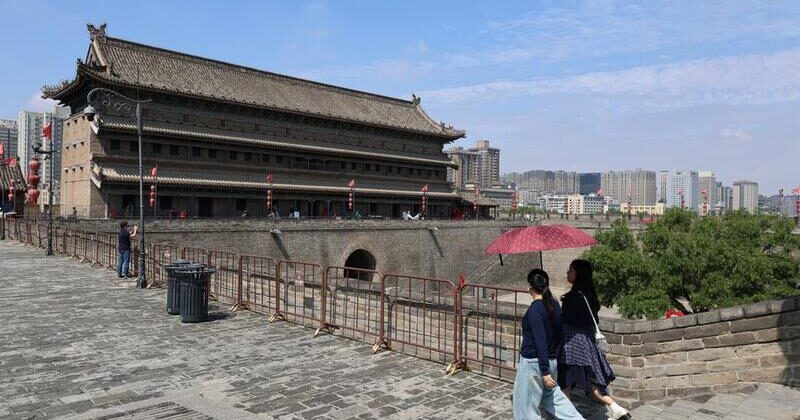by Xinhua writers Zhang Yunlong and Yang Yimiao
XI’AN, Oct. 27 (Xinhua) — On a crisp autumn morning in Xi’an, northwest China’s Shaanxi Province, security guard Zhang Jianli is seated by a gate to the west section of Huancheng Park, which encircles the entire square-shaped Xi’an City Wall. From his post, he greets a steady flow of visitors. Young people often stop to ask where in the park red spider lilies can be found. «Different seasons bring different flowers,» he tells Xinhua with a smile. «Many come just for the blossoms, but thousands visit every day.»
The park has become a beloved part of daily life for locals. Joggers weave through leafy paths, families stroll along the banks, and photographers capture the skyline framed by the centuries-old City Wall. But beyond these everyday scenes lies a quiet system of care for the wall’s preservation — one that merges ancient masonry with modern algorithms.
As one of China’s ancient capitals, Xi’an was at the heart of the Western Han (202 B.C.-8 A.D.) and Tang (618-907) dynasties — two of the most influential periods in ancient Chinese history. For Xi’an residents, the 13.74-kilometer City Wall is more than a scenic view. It’s a source of civic pride and a living link to the city’s millennia-old history.
Initially erected some 1,400 years ago — in 582 A.D., during the Sui Dynasty — the Xi’an City Wall was expanded extensively from 1370 to 1378 in the early Ming Dynasty, taking on the form it largely retains today. As one of the largest, oldest and best-preserved ancient urban fortifications in China, the wall now encircles the historic city, with 18 gates and more than 5,000 battlements. Yet its long life has not escaped scars. Wars and periods of neglect left it crumbling in places, and by the early 1980s, before Xi’an undertook a sweeping restoration campaign, much of the structure had fallen into a state of disrepair.
«When I joined the City Wall management office as a young man in 1981, I was tasked with surveying the damage, including collapses and malfunctions,» said Wang Su, now a veteran cultural relics protection expert. «Except for the South and West gates, most other gates and their towers were in poor condition, with missing bricks and collapsed roofs.» He remembers that near the north gate, some locals even grazed their sheep on the wall’s grassy top.
While some ancient city walls across China have been demolished in the last century, Xi’an’s has survived thanks to broad public and official support. It has remained under systematic protection, including a large-scale restoration and preservation campaign in the 1980s that engaged the community in wall repairs, moat dredging and the development of a surrounding park along the wall’s outer ring.
Today, data has become the wall’s newest guardian. High-precision 3D modeling — carried out through drone photogrammetry and fixed-point imaging — has mapped the entire structure, from its battlements and ancient murals to the surrounding park and moat, creating a complete digital foundation. Alongside this, more than 3,000 monitoring points and 1,300 smart devices track subtle signs of structural strain, caused by anything from settlement to displacement, and feed data into a central hub where AI analyzes and anticipates potential risks.
«Preserving the City Wall means combining generations of hands-on experience with digital tools, caring for it as one would an elder,» said Zhao Bin, head of the Xi’an City Wall Digital Industry Innovation Center. «At the same time, we aim to harness cutting-edge technology to distill new methods for cultural heritage preservation at home and abroad.» In this way, the ancient fortifications are both carefully nurtured and digitally alive.
The interior structure — mostly tamped earth — has been scanned using geophysical techniques similar to medical CT scans, revealing the number of voids and openings inside. These findings have informed targeted repairs that preserve the City Wall while also addressing hidden weaknesses. The project has even generated patents and software copyrights, underscoring technology’s growing role in heritage protection.
«Our biggest concern is water accumulation,» said Gao Heng, head of the cultural heritage protection department under the Xi’an City Wall management committee. «If water seeps into the bricks, it can damage the tamped earth inside. After each rain, inspections follow immediately.»
While technology plays a key role in its preservation, the City Wall remains deeply woven into daily life in Xi’an. Visitors bike along its 12-meter-wide top, watch cultural performances, or take photos in traditional Hanfu dress against the backdrop of its ancient gates. «I rode the whole loop in about two hours,» said Sara, 25, a visitor from Spain. «I love the contrast — the modern on the old.»
Around the wall, boutique cafes and guesthouses offer «wall-view» rooms that open onto the fortifications. «Xi’an people care for the wall out of deep pride,» said Nan Jianchun, a local driver. «It connects us to the 13 dynasties that once ruled from here.»
For Wang Su, the wall’s endurance is its greatest strength. «Many ancient walls exist in China,» he said. «But Xi’an’s stands out for its scale and completeness. Our goal is to keep history alive and relevant.»
By the time Zhang unlocks the park gates at dawn, early risers are already waiting to exercise. Within hours, the park fills with walkers, joggers, and fitness enthusiasts.
Watching the city evolve through centuries, the fortifications are more than blue bricks and tamped earth. Here, tradition meets technology, and the past breathes through modern life — brick by brick, byte by byte. ■



